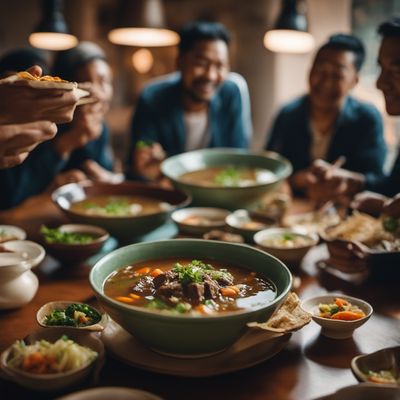
Recipe
Wajik - Sticky Rice Cake with Palm Sugar
Indonesian Delight: Sweet and Sticky Wajik Rice Cake
4.5 out of 5
Indulge in the rich flavors of Indonesian cuisine with this delightful recipe for Wajik. This traditional sticky rice cake, sweetened with palm sugar and infused with aromatic pandan leaves, is a beloved dessert in Indonesia.
Metadata
Preparation time
20 minutes
Cooking time
45 minutes
Total time
5 hours (including soaking and setting time)
Yields
6 servings
Preparation difficulty
Medium
Suitable for
Vegetarian, Vegan (if using vegan palm sugar), Gluten-free, Dairy-free, Nut-free
Allergens
N/A
Not suitable for
Low-carb, Keto, Paleo, Sugar-free, High-protein
Ingredients
-
2 cups (400g) glutinous rice 2 cups (400g) glutinous rice
-
2 cups (470ml) water 2 cups (470ml) water
-
1 cup (200g) palm sugar, grated 1 cup (200g) palm sugar, grated
-
4 pandan leaves, tied into a knot 4 pandan leaves, tied into a knot
-
1/2 teaspoon salt 1/2 teaspoon salt
Nutrition
- Calories (kcal / KJ): 250 kcal / 1046 KJ
- Fat (total, saturated): 0g, 0g
- Carbohydrates (total, sugars): 60g, 30g
- Protein: 2g
- Fiber: 1g
- Salt: 0.1g
Preparation
-
1.Rinse the glutinous rice under cold water until the water runs clear.
-
2.In a large bowl, soak the rice in water for at least 4 hours or overnight.
-
3.Drain the rice and transfer it to a steamer lined with a cheesecloth or banana leaves.
-
4.Steam the rice over medium heat for 30 minutes or until it becomes tender and translucent.
-
5.In a separate saucepan, combine the grated palm sugar, pandan leaves, and water. Cook over low heat until the palm sugar has completely melted and the mixture becomes syrupy.
-
6.Remove the pandan leaves from the syrup and pour it over the steamed rice. Mix well to ensure the rice is evenly coated.
-
7.Return the rice to the steamer and steam for an additional 15 minutes to allow the flavors to meld together.
-
8.Remove the steamed rice from the heat and let it cool slightly.
-
9.Transfer the rice to a square or rectangular dish lined with banana leaves or parchment paper. Press it down firmly to create an even layer.
-
10.Allow the Wajik to cool completely and set for at least 2 hours.
-
11.Once set, cut the Wajik into diamond-shaped pieces and serve.
Treat your ingredients with care...
- Glutinous rice — Make sure to rinse the rice thoroughly to remove excess starch before soaking. This will help achieve a fluffy and tender texture.
- Palm sugar — If you can't find palm sugar, you can substitute it with dark brown sugar. However, palm sugar adds a unique flavor to the Wajik.
- Pandan leaves — If fresh pandan leaves are not available, you can use pandan extract or essence as a substitute. Adjust the quantity according to the strength of the flavor.
Tips & Tricks
- Soaking the rice for a longer period of time, preferably overnight, will result in a softer and more tender texture.
- When cutting the Wajik into diamond shapes, lightly grease the knife with oil to prevent sticking.
- For an extra touch of flavor, you can sprinkle toasted sesame seeds or grated coconut on top of the Wajik before serving.
- Store any leftover Wajik in an airtight container at room temperature for up to 3 days.
Serving advice
Serve the Wajik as a sweet treat after a delicious Indonesian meal. It can be enjoyed warm or at room temperature. For an authentic touch, serve it on a banana leaf or a decorative plate.
Presentation advice
Arrange the diamond-shaped Wajik pieces on a serving platter, allowing their vibrant green color to stand out. Garnish with a sprig of fresh mint or a pandan leaf for an elegant presentation.
More recipes...
More Indonesian cuisine dishes » Browse all

Empal gentong
Beef soup
Empal gentong is a traditional Indonesian beef soup made with coconut milk and spices.

Soto ceker
Chicken feet soup
Soto ceker is a traditional Indonesian soup made from chicken feet, vegetables, and spices. It is a flavorful and aromatic dish that is often...

Sate lilit
Lilit Satay
Sate lilit is a traditional Balinese dish made from minced meat, coconut, and spices, which is then wrapped around a lemongrass stick and grilled...




